Fat Burning?

As you might expect, I get lots of cycling related questions on "fat burning" and weight loss.
Recently I did a ride, tagged as a fat burner, that was of a higher intensity than many would deem the consensus.
So here's a quick low down on fat burning, what it is, why it works, and how it can help you become a leaner, faster, stronger rider.
The Balance of Power
Weight loss is as key to your performance on a bike as building
power and getting fit. However, the
flamme rouge motto of, "everything
in moderation" applies as much here as it does anywhere else.
We don't want to end up like the Manorexic Pro's. We want to alter our power to weight ratio, but not at the expense of outright power.
Once you've reached an advanced level of sporting prowess it becomes disproportionally harder to get fitter. You have to work harder and harder to get back increasingly smaller performance gains.
We've talked about the Pareto Principle elsewhere, but effectively, at the top end, you don't always get back what you put in. So you have to play the numbers game.
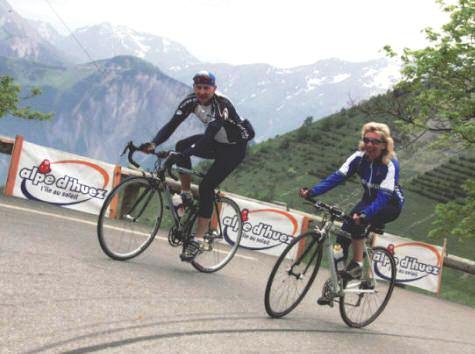
mr & mrs flamme rouge on their day off
To lose a kilo in weight is relatively easy, and desirable for most of us. A kilo weight loss will allow us to climb around two percent quicker, or climb at the same speed for two percent less "effort". I'm sure you realize how hard you would have to work to gain an extra two percent maximum aerobic power? So weight loss it is then.
As an aside, even though a kilo is probably less than 1% of your weight, when climbing, there's a multiplication factor applied for gravity, gradient, drag co-efficient, and all up bike/rider mass.
Glycogen Sparing?
Lots of riders believe that to burn fat you have to ride at a
slow, slow pace to make sure the body doesn't burn carbs. Which has it's merits, but is as boring as a bored thing in a bore
hole. Who has the time these days?
There's a subtle difference between "fat burning" and "glycogen sparing" but we don't have room or time for that today. Other than to say, the longer you can stay in your fat burning zone, at a higher proportion up the speed curve, the more glycogen you'll spare and have available come the last quarter of your event, when the prizes are won!
Here we'll discuss a quick way of getting the fat burning process started and getting your body to turn to burning fat sooner and for longer.
Become a Morning Person
It goes without saying, but I will anyway, that when you wake up,
your glycogen and hydration levels are probably at their lowest of
the day.
You've been asleep for up to eight hours and it's maybe ten hours since you last ate or drank. Although you've been inactive, your physiological resources are depleted. So now's the time to ignore everything I've said about fuelling up before training. There will be no "break of fast" this morning.
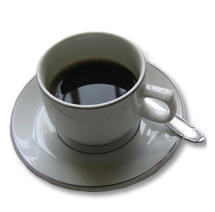 Get up, have a drink of water. Fill a drinks bottle
with water and get yourself a coffee,
maybe two. Strong, black, no sugar.
Get up, have a drink of water. Fill a drinks bottle
with water and get yourself a coffee,
maybe two. Strong, black, no sugar.
No food or carbs must touch your lips. Drag yourself to your bike, stick a gel in your back pocket and head out for the open road.
Ease your way in to the ride and ride at a steady, medium-to-fast cruising pace, making sure you don't get to a point where you're breathing hard and straying in to anaerobic teritory.
The caffeine will wake the body and fire up your metabolism. As you're resource depleted, there's precious little glycogen available. What is, has been reserved to fuel your primary body functions, the bits that allow you to survive and keep the bike upright.
Your body isn't going to allow life-preserving resources to be frittered away just so you can enjoy yourself on a morning jolly. With potential bike powering glycogen allocated elsewhere, your body looks for the primary back up fuel source, your fat reserves.
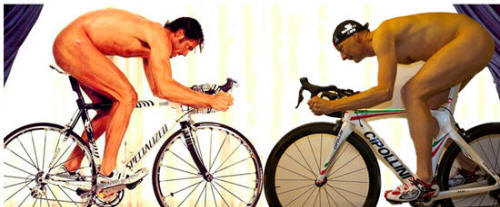
Mario Cipollini and yours truly in a fat off...
But I'm Not Fat...
A 70 kilo rider, with a measly 10% body fat, has seven kilos of energy dense
resources available to them. At 9 Calories per gram, this
gives around 77,000 calories of
potential energy. This isn't strictly accurate, but it is for our
purposes! An energy gel has around 150 calories, so you can
see this is an awful lot of gels.
As all rides are ridden using a combination of the aerobic/anaerobic energy systems. All rides burn a combination of fat and carbs. The faster you go the more these proportions change to a carb bias.
Below are the seven "energy" levels of riding your bike. If you have one of our programmes, or have been for a test, you'll be familiar with it. If not, far left is as slow as you like, far right is an eye-bleeding sprint.
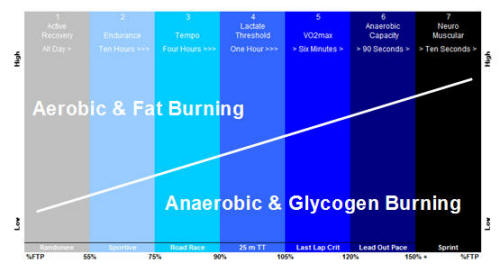
This is a conceptual diagram to show how the physiological
proportions change. It's just to give an impression of how your body
changes
when speed, represented by the white diagonal line, increases.
Once you've eased in to the ride, and the body has recognised there's fat available to use and is happily, but slowly, processing it, you can up the pace. Everyone is different, so you need to find where, on the diagram, your fat burning "hot-spot" is located.
Remember, fat burns in the flame of oxygen. Oxygen and breathing are important! So pay attention to your breathing patterns.
Aerobic exercise (left panels) burns fat, but at far too slow a rate for our purposes. We're flamme rougers, we have lives to be getting on with.
Anaerobic exercise (right panels) burns more calories, primarily from glycogen, but at a rate quicker than can be supplied in your early morning, fasted, state.
As you can see, there is no anaerobic threshold (there I've said it) it's a sliding continuum. We'll cover this another day.
Crack On...
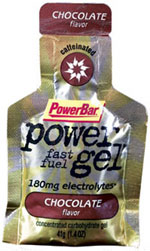 You'll be surprised at how fast, you can go, and for how long,
before you start getting "the signs".
You'll be surprised at how fast, you can go, and for how long,
before you start getting "the signs".
Don't stray too far from home, because if you bonk, you need to get back safely! That's what the gel's for. But if you do it right, you'll quickly get the hang of it and can get lean quickly.
Doing this type of ride at night doesn't have the same physiological returns. You've been eating carbs all day and your body is more reluctant to go looking for fat, no matter how slow you ride.
Also, at night, once you've done the ride, you may get three or four hours of metabolic return (if at all) before you go to bed and your body engine goes in to hibernation mode.
By doing these rides in the morning, you "switch on" to fat burning quicker, burn more fat, and have your metabolism fired up for the rest of the day. Which constantly burns calories, giving you an endorphin high while others around you are slumping. Everyone at work will just love you!
To be honest, initially it's a pain getting up early and doing these rides. But very quickly you see the returns for your, not even hard-earned, efforts. Once the summer starts, the early morning is usually the best part of the day. So give it a go.
You can often be out for up to 90 minutes, home, breakfast, shower and still be in work for the normal time. Knowing you've done your workout for the day gives you a little smug satisfaction that's hard to top.
You can even ride them as your commute in to work if you do them properly. Don't be racing every wannabe; stick to the programme!
If you ride them three times a week, for three weeks, you'll see a significant difference in your work, rest and play.
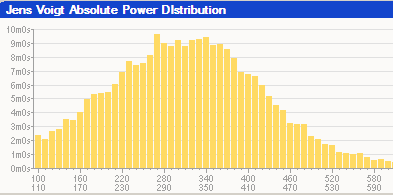
How Fast is Fast?
Generally, the figures given for your fat burning zone are up to 75%
of your max heart rate. Please don't use the 220-age
formula! But some are more pre-disposed, and genetically
gifted, to burning fat than others. So find your range.
Not
that of your mate, not what it says in a book, or even in the sentence
above. Find what works for you.
The fitter you are, the higher up the sliding line you can go. Those new to the sport might have to stay in boxes one and two. First year riders, possibly two and lower three. Experienced riders, lower three?
Over time, the diagonal line will drift downwards (or to the right) giving you a more efficient output for a given input. The boxes will always stay the same, but the power/speed/heart parameters will change.
 If you have a power meter, then use that to set your "FATmax"
intensity.
If you have a power meter, then use that to set your "FATmax"
intensity.
You may need to do a test, but you should be able to get a ball park figure yourself by simulating a test on the road or just paying attention to your breathing.
Losing weight is about the total number of calories you burn against those you consume. A negative balance will help you lose weight. This isn't our objective here. But it may be a consequence.
You can't target fat loss to a specific area of your body. What we're looking to do is lower our total fat content, and this normally happens on the sub-cutaneous layer just under the skin. You'll sharpen up your muscle definition if nothing else.
We shouldn't ignore protein as a fuel, but we will here! We'll cover protein another day as it's at the end of the energy chain and if you're burning protein for energy, you're in big trouble! Get protein down you at the end of the ride. A glass of milk is perfect. But not the full-fat version!
The Sums ~ Slow v Fast
In the old days (about ten years ago!),
for fat burning, you'd ride at a slow pace,
say 60% max heart rate and burn 1000 calories. Forty percent
of which would come from your fat stores.
In the ride I did, I rode at 75% of my max heart rate for two hours and burnt 1400 calories. But only 33% came from my fat stores.
The first ride would of bagged 400 fat calories, the second ride bagged 462 fat calories and burnt an extra 400 calories to boot. It also gave me a higher elevated metabolism, for longer, for the rest of the day. How good is that?
At best, you can probably burn up to 250 fat calories per hour, but you need tons of equipment (and a pot of money) to measure this accurately. So you need to be in this for the long game. Throwing in a ride once a week, ain't going to move much fat.
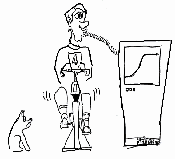 Longer v Shorter
Longer v Shorter
You will burn fat if you ride for thirty minutes slowly. But
it may take fifteen minutes to "wind the machine up". So
you've had fifteen minutes "burning fat".
A sixty minute ride will still need the fifteen minute pre-requisite, but now you get forty-five minutes of fat burning.
The same goes for a two hour ride, a hundred and five minutes of which could be fat burning. Seven times the benefit of the thirty minute ride for four times the duration. But two hours should be your maximum ride time.
So, for a weekly basis. Two, two hour rides rides are preferable to four, one hour rides, and much more preferable than eight, half-hour rides. You also get the benefits of cumulative recovery with the longer rides.
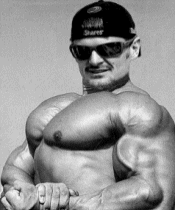 Muscle Up Oldies
Muscle Up Oldies
Muscle is metabolically more active than fat. Fat is inert, it
doesn't require "stuff" to maintain it. Muscles do.
So vet (over 40's) riders can help themselves by doing resistance training to "maintain" muscle mass, but not build it.
Muscles are heavy and require dragging up a hill. Don't burn fat and replace it with muscle; that's not a winner.
But increasing your muscle mass will increase your metabolism and ironically, help you stay leaner.
That's why our programmes have two gym, weights, stretching sessions a week. One reason is to stop you going on your bike and overtraining, the other is to help you lose weight, burn fat and raise metabolism.

smelling the flowers, riding fast-ish,
mouths closed, fat burning ride...
Jason Stratford and me, like a big girl,
with gilet and arm-warmers
The Message
Riding very slow burns fat and carbs. But it also uses
energy (calories) at a slow rate and gives a low rate of return.
Riding very fast burns carbs and fat. But uses energy at a very fast rate, which means you can't do it for very long, resulting in a medium rate of return.
Riding fast, burns fat and carbs and uses energy at a fast rate. Giving the best return on your training investment.
Ride fast enough, in a fasted state (sic) in the morning and you will burn a greater proportion of fat, quicker, and elevate your metabolism (which continues to consume energy) for longer. Job done.
As you progress in to the ride, you can raise your effort, but be careful not to go in to the "heavy breathing" zone. Rhythmic breathing is okay, but if you're sweating and gasping for breath, you better get that emergency gel ready because you're going to need it to get home.
Until next time my skinny cycling chums...








